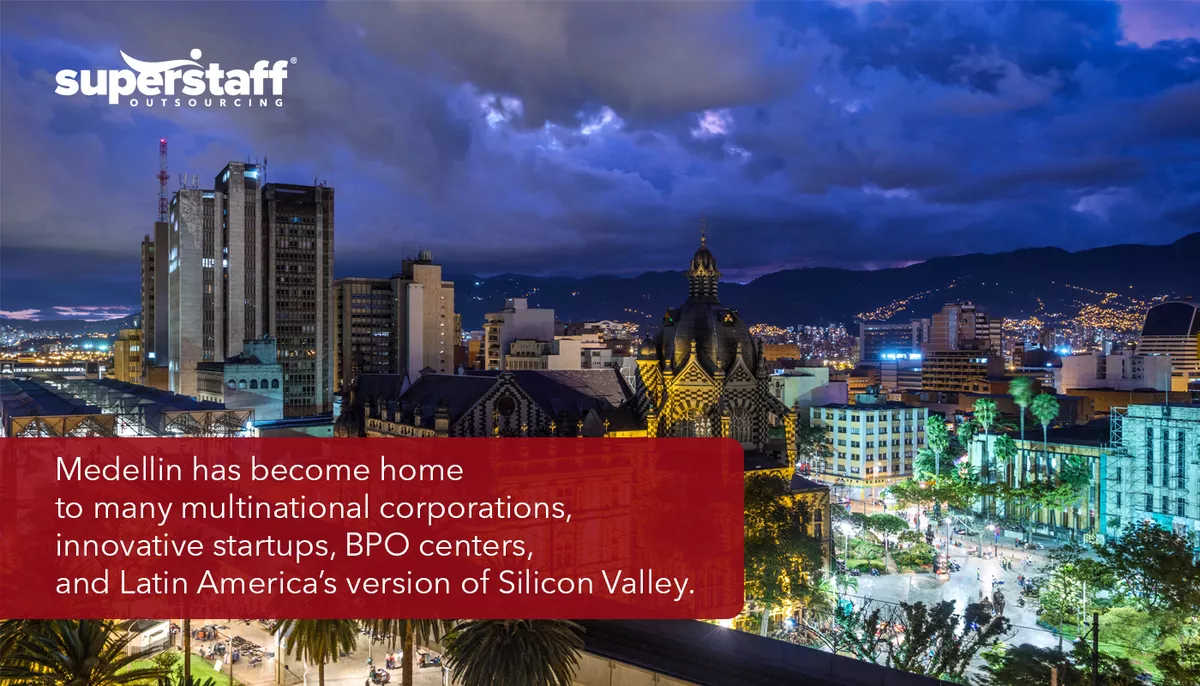
Few other places in the world have managed to pull off the incredible transformation achieved by Colombia.
There were doubts about the country’s political and economic stability in the past, which meant that many global businesses were wary about establishing headquarters in the nation.
Today is a vastly different story. For over a decade, Colombia has emerged as one of the best places in Latin America to do business, especially in nearshoring.
The State of Colombia Today
Why do companies in the United States and worldwide view Colombia as a favorable destination for business investment?
Here are just a few of the most powerful reasons:
Positive Economic Outlook
Among the largest Latin American countries, Colombia has one of the fastest-growing economies, maintaining incredible activity levels throughout the pandemic.
The country’s GDP grew by 7.5% in 2022 after rising 11% in the previous year. Industry experts foresee a continuous positive upward trend for the nation’s economy in 2023 and beyond.
Ease of Doing Business
According to the World Bank’s 2019 Doing Business Report, Colombia is ranked as the 2nd friendliest nation in South America for establishing and maintaining businesses. The following year, Colombia was ranked 67th out of 190 economies in the same report, with industry experts citing the country’s flexibility in employment regulation and open business environment as key competitive advantages.
Because of the relative ease of doing business in Colombia, foreign direct investments (FDI) have been increasing in recent years. In 2021, global companies invested $7.2 billion in the nation, rising by 4.8% compared to the previous year.
Global Competitiveness
In the 2019 IMD World Competitiveness Ranking, Colombia ranked 1st in labor market efficiency in Latin America. By 2023, the same annual report listed the South American country as 58th overall in global competitiveness, coming in 3rd in the region after Peru and Mexico.
Solid Labor Force Participation Rates
Colombia is Latin America’s third most populated nation, boasting over 50 million people. The country also had a strong labor participation rate in 2022, estimated at 59.80%. Industry analysts expect Colombia’s workforce participation rate to rise even further, reaching about 62.50% this year and 63% by 2024.
Ease of Collaboration With Western Economies
Being a multicultural country, many Colombians are bilingual and highly proficient in English and Spanish, making them ideal candidates for BPO roles where cooperation with global teams is necessary. Because of Colombia’s geographical proximity to the United States, collaboration between remote workers is much easier due to similar or more closely aligned time zones.
Growing Tech Workforce
As global companies push to accelerate their digital transformation initiatives, one major challenge stands in their way: the widespread tech talent shortages.
Between 2021 and 2031, industry analysts expect that the demand for software developers and engineers will grow by 25%. However, there may be insufficient talent in the U.S. and other Western economies to meet the continually rising demand.
Thankfully, Colombia is looking to fill that void. The South American nation is investing in the digital skills education of its citizens, with Medellin, in particular, housing several tech boot camps and universities offering IT courses.
As of 2023, Colombia has produced over 100,000 engineers and 10,800 IT specialists. U.S. companies can tap into this highly skilled workforce through nearshore software development outsourcing.
Among the many cities in Colombia, the country’s central tech hub is Medellin.
Notable Infrastructure Developments in Medellin, Colombia

Once seen as among the world’s most dangerous cities during the 1980s and 1990s, Medellin has become one of the safest and most innovative places on earth. Under the leadership of its former mayor Sergio Fajardo, the city government made significant investments in civic architecture and public infrastructure.
Over the last decade, Medellin’s transformation continued leveling up. The local government has been using public projects to reinvigorate the city’s urban fabric, improve life for some of their more underprivileged districts, create inclusive and socially equitable community spaces, and uplift their social, cultural, and economic competitiveness.
This is why more and more businesses see Medellin’s potential as Latin America’s top investor-friendly economic hub. Global companies are establishing headquarters in the Colombian city because of many of their new infrastructure developments.
Check out these interesting facts about Medellin’s infrastructure:
The local government prioritizes infrastructure development to increase the country’s global competitiveness.
In 2016, the Colombian government moved to foster greater stability in Medellin by signing a Peace Agreement with the FARC. This guerilla group had been causing dissent and conflict in the area for over five decades.
As the order was established in the country, then-president Juan Manuel Santos prioritized infrastructure development to bring Colombia into a new era.
The first project initiated by the Santos administration was the multimodal transportation program aiming to improve connectivity between different regions. The initiative included:
- 101 road projects
- 52 highway projects
- 5 railway projects
- 8 fluvial projects
- 31 airport projects
- Various dredging initiatives
The ambitious plan, which was divided into two major programs–known as fourth-generation projects (4G) and fifth-generation projects (5G)–was valued at 10.4 trillion Colombian pesos (equivalent to $2.7 billion), worth about 1.3% of the country’s GDP.
The 4G infrastructure projects were developed to promote Colombia’s economic development by connecting industrial regions with the nearest ports. These included 29 road projects, including:
- Constructing 4,970 miles worth of dual carriageways
- Repairing 4,349 miles of roads
- Creating 141 tunnels
- Building 1,300 viaducts
Meanwhile, the 5G infrastructure initiatives encompass:
- 7 road projects
- 4 airport projects
- 2 river projects
- 1 airport project
Thanks to these infrastructure initiatives, Colombia improved its ranking in the Global Competitiveness Index (GCI) starting in 2017. That year, Colombia claimed the 66th spot out of 140 economies. By 2018, the country increased its ranking to 60, achieving 57 by the following year.
As the Latin American nation continues to prioritize infrastructure development and stability, experts from the World Economic Forum predict that it will continue increasing its global competitiveness for years to come.
Medellin’s “social urbanism” philosophy revitalized neighborhoods and communities from the once-troubled city.

As mentioned above, Medellin was once seen as among the most dangerous cities in the world. However, with the fall of Pablo Escobar and the city’s most prominent drug cartels in the mid-1990s, the city experienced a significant rebirth.
In 1991, the city had a homicide rate of 381 for every 100,000 residents. Now, safety in Medellin has become of utmost priority to its local government, pushing forward a more vigorous crackdown on gangs and making remarkable efforts to address poverty.
Violent crime in the city has decreased significantly, now comparable to crime rates in major U.S. metropolitan areas like Washington, D.C.
In addition to addressing criminal activity through the expansion of military and policing forces, another primary reason for Medellin’s incredible transformation was its commitment to improving public infrastructure.
During his administration, Sergio Fajardo crafted policies to repair Medellin’s damaged social fabric by enhancing its social, cultural, and physical infrastructures. His initiatives included the construction of the Parque Biblioteca España, a library park renowned for its magnificent architecture, which was completed in 2007.
Fajardo and his contemporaries also approved the development of bridges and trams that connected poorer districts to the more economically developed areas. They created digital maps that enabled the government to understand gang operations better and designed architectural features to discourage and disrupt gang violence.
BPO Developments in Colombia
Continued supply chain woes have increased the demand for nearshoring in Latin America.
From the ripple effects of the COVID-19 lockdowns to ongoing international supply chain problems, today’s businesses face so much uncertainty and disruption. These unexpected challenges highlighted the importance of geographical proximity in the supply chain.
In the past, multinational corporations entrusted their manufacturing and supply chain operations to faraway countries like China and India. Today, more businesses are discovering the advantages of moving their operations closer to home through nearshoring.
Latin America, Colombia in particular, has become the go-to nearshoring location for many companies. In fact, the Inter-American Development Bank (IADB) has estimated that the demand for nearshoring could add $78 billion to the region’s export value by 2025.
Colombia’s booming economy and solid infrastructure are making the country a prime destination for nearshore outsourcing.
In previous sections, we’ve mentioned how more foreign companies are eyeing Colombia as an investor-friendly economic hub. This is especially true for the global business process outsourcing (BPO) market.
For over 20 years, Colombia has been among Latin America’s leading destinations for outsourcing services and one of the first countries to benefit from the growing push toward nearshoring.
In 2019, the Colombian government began promoting the country as an emerging nearshoring market, and it has since attracted over $1 billion in foreign investments worldwide.
With Colombia’s continually improving tech infrastructure, experts predict that more companies will turn to the country for knowledge process outsourcing solutions, including information technology (IT), software development, and data analytics.
Alongside various infrastructure projects, the local government plans to invest in tech education and training to support the demand for specialized outsourcing services.
Colombia has become one of the world’s most prominent BPO and KPO providers.
According to a 2022 BPO Sector Data Report, Colombia is now one of the top outsourcing destinations globally, experiencing an 8% growth in BPO exports and 18% for KPO roles. Revenue for these outsourcing solutions surpassed $1.98 billion within the same year, with BPO alone contributing 3.5% to the country’s GDP.
Offering lower operational costs and greater scalability of services, outsourcing has become an excellent strategic option for many global businesses.
In addition, the BPO sector is one of the biggest job creators in Colombia, generating about 705,000 new jobs for workers across the country.
Industry analysts cite Colombia’s stable business environment, favorable government policies, and proximity to many major U.S. economic centers as key reasons for the BPO industry’s continued success in the nation.
Is Medellin, Colombia Safe for Business? Trust the BPO Professionals at SuperStaff To Safeguard Your Operations
As Colombia continues its path toward increased stability, improved global competitiveness, and greater innovation, now is the time for multinational companies to make smarter investments.
By nearshoring to this Latin American nation, your business can fill the gaps in your talent pipeline and enhance operational efficiency, all while reducing costs.
Here at SuperStaff, we have a team of exceptional outsourced Colombian professionals. Our BPO company takes advantage of Medellin’s robust infrastructure and technology to provide world-class outsourcing services that can be customized to your specific business needs.
Contact us today, and let’s discuss how our nearshoring solutions can benefit you!






